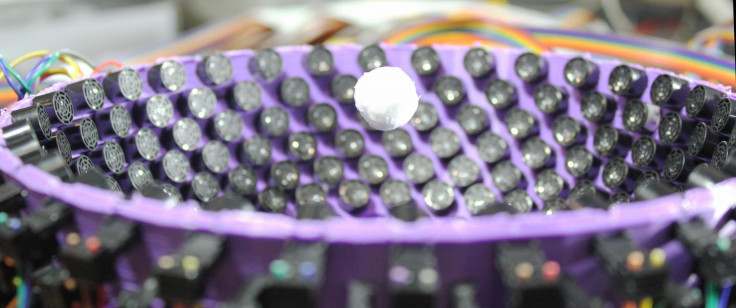Tractor beam that could one day levitate humans created by scientists
A new acoustic tractor beam uses rapidly rotating 'tornadoes' of sound to suspend objects in mid-air.
Tractor beams – devices with the ability to attract one object to another from distance – may seem like the stuff of science fiction.
But new research has brought a working tractor beam, powerful enough to levitate a human, closer to reality. Scientists from the University of Bristol were able to suspend relatively large objects in mid-air using only the power of sound.
Acoustic tractor beams use a vortex of sound to suspend both liquid and solid particles in the air. However, until now, it has not been possible to hold an item steady if it is larger than the wavelength of the sound being produced inside the device.
Scientists thought that acoustic tractor beams were fundamentally limited to levitating small objects, as objects larger than the sound wavelength would spin uncontrollably and be ejected from the device.
However the new approach, described in a paper published in the journal Physical Review Letters, works by creating rapidly rotating 'tornadoes of sound', which generate a vortex characterised by a silent core and a loud exterior.
The Bristol team found that they could stabilise the tractor beam by rapidly switching the direction the 'tornadoes of sound' were twisting. They also managed to increase the size of the silent core, enabling the tractor beam to hold larger objects.

In a demonstration, the researchers were able to hold a 2cm-wide polystyrene ball in a stable position in the middle of the tractor beam using ultrasonic sound waves at a frequency of 40 kilohertz (kHz) – which is inaudible to humans, but can be heard by certain animals, such as bats.
The sphere was more than double the size of the wavelength of sound at 40 kHz, indicating that the technique holds promise for levitating much larger objects.
"In the future, with more acoustic power it will be possible to hold even larger objects," said Mihai Caleap, an author of the study. "This was only thought to be possible using lower pitches making the experiment audible and dangerous for humans."

The new findings open the door for the technology to be used in a variety of settings, according to the researchers.
"Acoustic tractor beams have huge potential in many applications," said Bruce Drinkwater, who supervised the work. "I'm particularly excited by the idea of contactless production lines where delicate objects are assembled without touching them."
In addition, the technology could be used for transporting delicate objects or manipulating micro-surgical instruments inside the body.
"Now we can use high-frequency ultrasound to image and manipulate particles," Asier Marso from the University of Bristol told IBTimes UK.
"This permits us to employ the same machines that are used for ultrasonic imaging to trap particles, allowing doctors to control particles inside the body and see them at the same time. For instance, we can trap and dispose stones inside a kidney or we can control drug capsules from the exterior of the body to guide them towards the target area that requires the medication."





















